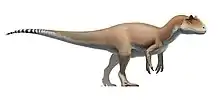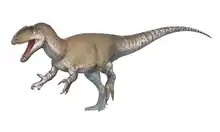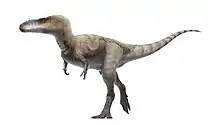| Spinostropheus Temporal range: Middle Jurassic, | |
|---|---|
 | |
| Life restoration of S. gautieri | |
| Scientific classification | |
| Domain: | Eukaryota |
| Kingdom: | Animalia |
| Phylum: | Chordata |
| Clade: | Dinosauria |
| Clade: | Saurischia |
| Clade: | Theropoda |
| Clade: | †Ceratosauria |
| Genus: | †Spinostropheus Sereno et al. 2004 |
| Type species | |
| †Spinostropheus gautieri Lapparent, 1960 (originally Elaphrosaurus gautieri) | |
Spinostropheus is a genus of carnivorous ceratosaurian theropod dinosaur that lived in the Middle Jurassic period and has been found in the Tiouraren Formation, Niger. The type and only species is S. gautieri.
History of discovery
In 1959, Albert-Félix de Lapparent excavated fossils near Oued Timmersöi, west of In Tedreft in the Agadez desert. Among the finds were the remains of a theropod. In 1960, de Lapparent, based on these, named a second species of the genus Elaphrosaurus, E. gautieri. The specific name honours François Gautier, the discoverer of the type locality.[1]
In 2004, Paul Sereno, John Wilson and John Conrad named a separate genus: Spinostropheus. The generic name is derived from Latin spina, "spine", and Greek στροφεύς, stropheus, "vertebra", and refers to the epipophyseal processes of the cervical vertebrae, which are prominent and dorso-ventrally flattened.[2]
The holotype, MNHN 1961-28, was found in a layer of the Tiouraren Formation dating from the Bathonian-Oxfordian.[3] De Lapparent had presumed that the strata dated from the Early Cretaceous. It consists of a cervical vertebra, seven pieces of the dorsals, three pieces of the sacrum, five tail vertebrae, a humerus, the lower end of a pubic bone, the lower end of a thighbone, a piece of a shinbone, a piece of a fibula, a metatarsal, four additional pieces of the metatarsus and a phalanx of a toe. The paratypes were an ulna, a metatarsal and a second partial skeleton consisting of vertebrae and limb elements. In 2004, Sereno e.a. referred a third skeleton, specimen MNN TIG6 consisting of a series of cervical and dorsal vertebrae together with some ribs.[2]
Description
Spinostropheus was a relatively small theropod. In 2010, Gregory S. Paul estimated its length at 4 metres (13 feet), and its weight at 200 kg (441 lbs).[4] In 2012 Thomas R. Holtz Jr gave a length of 6.2 meters (20.3 feet).[5]
Classification
In 2002, a cladistic analysis by Sereno et al found Spinostropheus to be the sister taxon of the Abelisauria. In this study only the data from specimen MNN TIG6 were considered.[6] Subsequent studies have confirmed the original interpretation as a basal ceratosaur, outside of Neoceratosauria, more closely in the evolutionary tree to Elaphrosaurus.[7] Rauhut and Carrano (2016) believe that the holotype and paratype specimens of Spinostropheus lack ceratosaurian features, unlike the specimen MNN TIG6 which they consider ceratosaurian, and suggest that Spinostropheus might be a basal tetanuran.[8]
See also
References
- ↑ A-F. de Lapparent, 1960, "Les Dinosauriens du "Continental intercalaire" du Saharal central", Mémoires de la Société géologique de France, nouvelle série 39(88A): 1-57
- 1 2 Sereno, P. C.; Wilson, J. A.; Conrad, J. L. (2004). "New dinosaurs link southern landmasses in the Mid-Cretaceous". Proceedings of the Royal Society B: Biological Sciences. 271 (1546): 1325–1330. doi:10.1098/rspb.2004.2692. PMC 1691741. PMID 15306329.
- ↑ Rauhut, O.W.M.; Lopez-Arbarello, A. (2009). "Considerations on the age of the Tiouaren Formation (Iullemmeden Basin, Niger, Africa): Implications for Gondwanan Mesozoic terrestrial vertebrate faunas". Palaeogeography, Palaeoclimatology, Palaeoecology. 271: 259–267. doi:10.1016/j.palaeo.2008.10.019.
- ↑ Paul, G.S., 2010, The Princeton Field Guide to Dinosaurs, Princeton University Press p. 78
- ↑ Holtz Jr., Thomas R. (2012). "Dinosaurs: The Most Complete, Up-to-Date Encyclopedia for Dinosaur Lovers of All Ages" (PDF).
- ↑ Sereno, P.C.; Conrad, J.L.; Wilson, J.A. (2002). "Abelisaurid theropods from Africa: Phylogenetic and biogeographic implications". Journal of Vertebrate Paleontology. 22 (3): 106A.
- ↑ Carrano, M.; Sampson, S. (2008). "Phylogeny of Ceratosauria (Dinosauria: Theropoda)". Journal of Systematic Palaeontology. 6: 183–236. doi:10.1017/s1477201907002246.
- ↑ Rauhut, Oliver W. M.; Carrano, Matthew T. (November 2016). "The theropod dinosaur Elaphrosaurus bambergi Janensch, 1920, from the Late Jurassic of Tendaguru, Tanzania". Zoological Journal of the Linnean Society. 178 (3): 546–610. doi:10.1111/zoj.12425.

.jpg.webp)












